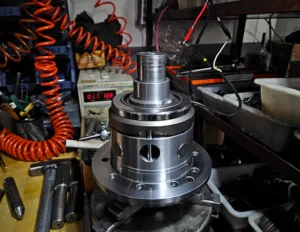
Understanding how a car’s transmission system works can be fascinating. Let’s break down the process in simple terms.
The transmission system in a car is like a middleman that ensures the power generated by the engine gets to the wheels efficiently. Without it, you wouldn’t be able to control your speed or torque (which is the force that gets your car moving).
How Transmission Systems Work in Automobiles
First, the engine burns fuel to create power. This power starts as a linear motion (back and forth) of the pistons. The crankshaft then converts this linear motion into rotational motion.
The crankshaft spins and sends this rotational energy to the transmission. Think of the crankshaft as a translator turning the engine’s energy into a form the car can use.
The transmission’s main job is to adjust this rotational energy. Depending on how fast you want to go and how much power you need, the transmission changes gears. Lower gears provide more torque for things like starting from a stop or climbing hills, while higher gears are for cruising at high speeds.
Next, the driveshaft comes into play. It’s like a long tube that takes the adjusted power from the transmission to the car’s rear end. Imagine it as a messenger carrying the engine’s power to where it’s needed.
Now, when you turn your car, the wheels on the inside of the turn travel a shorter distance than the wheels on the outside. The differential allows the wheels to spin at different speeds to make turns smooth and easy. Without it, turning your car would be a jerky and difficult task.
Types of Transmission Systems
Manual Transmission
Manual transmissions require the driver to manually change gears using a clutch and a gear stick. It’s a bit like playing an instrument where you have to be in sync with the rhythm of the engine.
Automatic Transmission
Automatic transmissions do all the work for you. They automatically select the appropriate gear based on your speed and acceleration, making driving easier, especially in stop-and-go traffic.
Continuously Variable Transmission (CVT)
CVTs don’t have fixed gears. Instead, they use a system of belts and pulleys to provide a seamless range of gear ratios. This results in a smooth driving experience and often better fuel efficiency.
Dual-Clutch Transmission (DCT)
DCTs use two clutches – one for odd-numbered gears and one for even-numbered gears. This allows for faster and more efficient gear changes, combining the best features of both manual and automatic transmissions.
Conclusion
In summary, the transmission system in a car is a critical component that bridges the gap between the engine and the wheels. It ensures that the power generated by the engine is effectively utilized to control the car’s speed and torque, allowing for smooth and efficient driving. Whether it’s a manual transmission that requires driver input, an automatic transmission that handles gear changes seamlessly, a CVT that offers a continuous range of gear ratios, or a DCT that provides quick and efficient shifts, each type of transmission system plays a vital role in enhancing the driving experience. Understanding how these systems work helps us appreciate the complexity and engineering that go into making our cars run smoothly.



